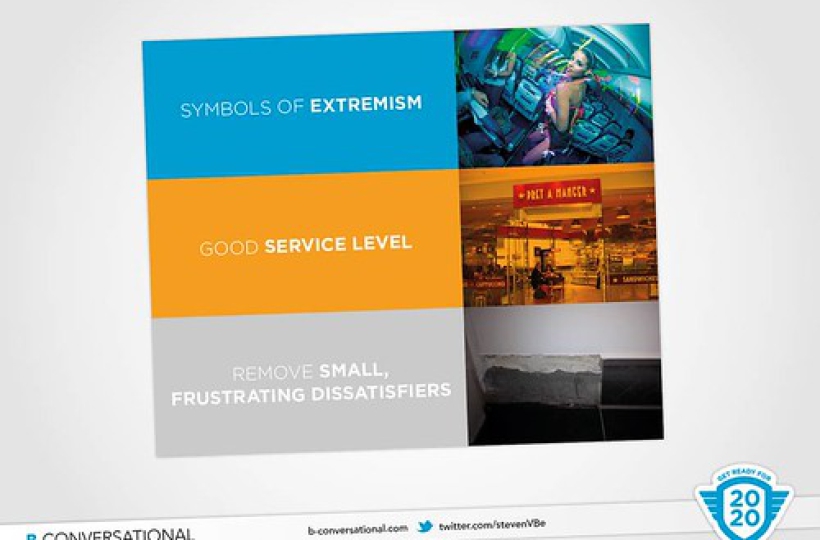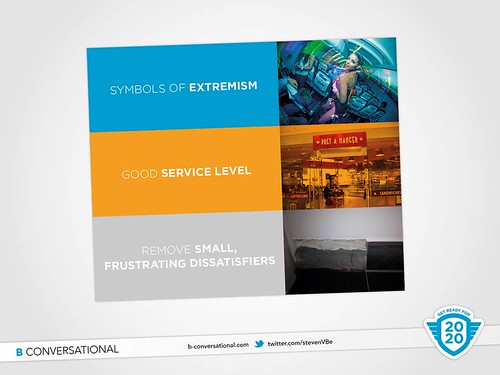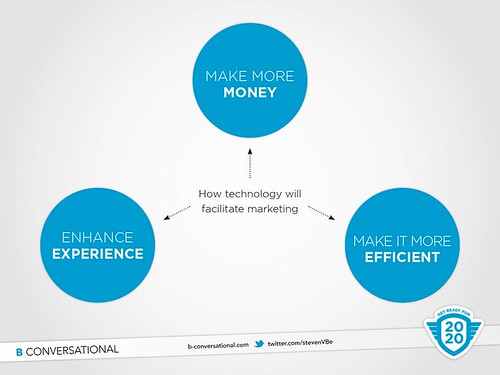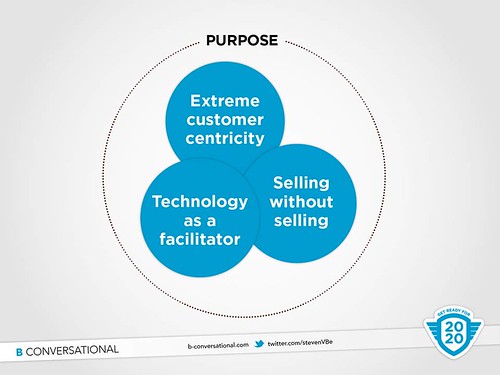Are you ready for Marketing 2020?

For many companies, 2020 acts as a symbolic deadline, with many strategic plans working towards that date. Everyone is convinced that the face of marketing and entrepreneurship will have changed profoundly by the time 2020 rolls around. Based on my discussions with experts, literature and my personal vision and experiences with customers, I have compiled an overview of what marketing 2020 might look like.
This blog post summarizes the main elements of the presentation.
The 2020 Consumer
To develop the marketing philosophy of the future we also need to understand the 2020 consumer. Three factors will continue to influence consumer behavior:
- Full adoption of new technologies: by the year 2020 some 2.5 billion smartphones will be in use. Much more than is the case today, the internet and digitization will be the most natural thing in the world.
- Transparency: the continued adoption of technology will make the world even more transparent. Consumers will be perfectly aware of which companies are doing well and which aren’t. As a result, consumers will demand better service. Instead of simply comparing companies with the competition, they will compare them with class-leading companies. This will raise the bar considerably.
- Selectivity: technology will become even more effective at shielding consumers from commercial messages. New media will enable consumers to be very selective about which companies he or she is linked with. Gaining access to the 2020 consumer will prove extremely difficult.
The video below describes the 2020 consumer:
Extreme customer centricity as the central philosophy
A score of 7.3 out of 10 will not be enough to win the heart of the 2020 consumer. Only extreme customer centricity will guarantee success. Extremism may not be a good thing where politics and religion are concerned, but in marketing 2020 it is an absolute necessity.
Going extreme means facing several challenges:
- Extreme in the basic aspects: extreme customer centricity is often associated with exotic ideas but such ideas only work when the foundations are solid. Step one consists in compiling an inventory of all the annoying little customer frustrations and dealing with them one by one. A top-notch basic experience is the cornerstone of extreme customer centricity.
- It’s all about ‘influence’, not ‘influencers’: Every customer exerts influence. The illusion that a few select influencers determine the perception of an entire industry belongs to the classical school of thought. Treating all customers the same is exactly what brings about structural positive conversations. Focusing solely on ‘influencers’ may even have the opposite effect. Remember what happened with Yoep Van ‘t Hek and T-Mobile.
- Symbols of extremism: once a company exceeds expectations with regard to basic service levels, that company needs symbols of extremism. They are ideal conversation starters because they give satisfied customers something concrete to use when recommending your product. Zappos’s 365-day return policy, e-retailer Coolblue’s offline stores and KLM’s 30-minute reply policy to tweets are examples of such symbols.
Developing this philosophy amounts primarily to reevaluating customer processes. It boils down to optimizing the functional relationship. The additional challenge in this regard consists in adding a personal touch. Even the most expertly executed process feels impersonal without a smile. Friendly people can give a personal touch, and so can smooth communication and the occasional ‘random act of kindness’. It’s not hard to come up with but all the more difficult to implement properly.
And finally, extreme customer centricity is not about online presence or online customer service, although this is obviously part of the package. In the meantime, it is clear that 80 to 90% of your online success depends on your offline behavior. In 2020, a successful company will no longer differentiate between online and offline channels.
Technology integrated in marketing & service
Extreme customer centricity is a conscious investment on behalf of a company and technology can be of help on three different levels:
- Further improving the customer experience: new technology can enhance the customer experience. Technology can bring stunning innovations. For instance, Disneyworld is currently testing new Mickey suits. The suits are interactive and the guests can talk to Mickey. The suits create a new customer experience for the young and old.
- Increasing efficiency: technology can streamline certain processes. For instance, technology can help service evolve towards a self-service environment where the customers themselves can solve problems more quickly and efficiently. As a result, customer satisfaction goes up and costs go down. Ordering hamburgers at McDonald’s via the interactive screens is another example: waiting times are shorter and McDonald’s needs fewer staff.
- Generating more profit: Amazon adjusts its prices several times a day and this process is fully automatic. This perfect price strategy adds turnover and customers know that Amazon offers the sharpest prices 24 hours a day.
‘Data’ will obviously be one of the buzz words for marketing 2020. Compiling customer data will help companies achieve each of the three goals described above. Data will become the new oil, as it were. The richest company will be the one with the best data and the ability to use that data to maximum effect.
The future of selling will be selling without actually selling
Snagging consumers will become more and more difficult. Today, consumers go looking for interaction with no more than five brands. Technology is making it increasingly easy for consumers to shield themselves from commercial messages. Being extremely relevant is the only way of keeping the consumer’s attention going. There are two dimensions to support this philosophy.
The first dimension is the rise of inbound marketing. ING bank recently reported that 95% of customer interactions originate with the customer. In other words: the pull model has already replaced the push model. Data are absolutely invaluable in order to be relevant. Your company will need to create the perfect personalized message on the basis of data if it is to earn the consumer’s attention.
It’s quite funny, really: the foundation of marketing 2020 was described in the 80s, back when CRM and direct marketing were hot. Today we can finally execute what was described back then. The philosophy is sound and modern technology makes it possible.
A second dimension consists in offering relevant content. Content tells a story and gives people something of value. It’s less and less about your own product and more and more about what consumers can do with that product. The new sites for Kraft and Coca Cola already carry out that message. In both cases, the product itself has been pushed to the background and both sites look more like a digizine than a website. This is selling without selling.
Four principles are essential to success:
- Invest in your own media: link your content to your own media instead of letting it float around on the internet. Try to lure consumers to your own platforms to consume content.
- Content as bait for data: content is a bit like baiting the hook when going fishing. Many companies are simply throwing worms into the water: a fish comes along, swallows the worm whole and it’s gone. By attaching that bait to a hook, customers get hooked in when trying to take a bite out of the worm. Use this metaphor in your content marketing and capture data through your content.
- A mix of big and small stories: sharing stories on a day-to-day basis is part of the 2020 marketing philosophy, but take care to alternate between big and small stories. Red Bull are the undisputed masters in this respect. They come up with amazing stunts from time to time, but they also maintain a content flow that suits the brand. Both aspects are important.
- Design, design, design: content should be relevant but, more than anything, it should be well-designed. There’s a phenomenal difference in impact between a classic story and an engaging story. Designers will become increasingly important in the years to come.
Three dimensions to benefit a ‘bigger’ cause
Even a company that excels in each of these three dimensions (extreme customer centricity, technology and selling without selling) has no guarantees of success in 2020. First of all, you need a personal touch (see above), but you should also identify a common goal for the consumer and your company. Pampers has chosen to tackle a few nasty diseases with the consumer’s help: for every Pamper sold, a child in a developing country is inoculated, thus creating a common objective for consumer and company to work towards. As for Triodos bank, the company leaves its customers with no doubt what their money is invested in. Triodos only invests in projects promoting durability.
This kind of ‘bigger cause’ appeals to consumers. A global study by InSites Consulting about CSRclearly showed that consumers expect three things from a company: 1. Do good for your own customers, 2. Make a profit and thereby do good for your own staff and 3. Do good for society.
How does your marketing department rate on these three dimensions?
I sometimes get comments along the lines of ‘Steven, it all sounds so simple that I don’t understand why so few companies are able to properly implement this’. The same is also true of the 2020 marketing story. (I hope) it sounds very logical and easy, but putting it all into practice has proven far from evident.
Ask yourself the following question: How does my own marketing department rate on these 2020 dimensions? How many companies do I know today that do well on each of these three dimensions?
And then, of course, there’s also the key question: how do I rate on these three dimensions?
Hope you enjoyed the post, please let me know how you see the future of marketing. Tell me how you see Marketing 2020.



